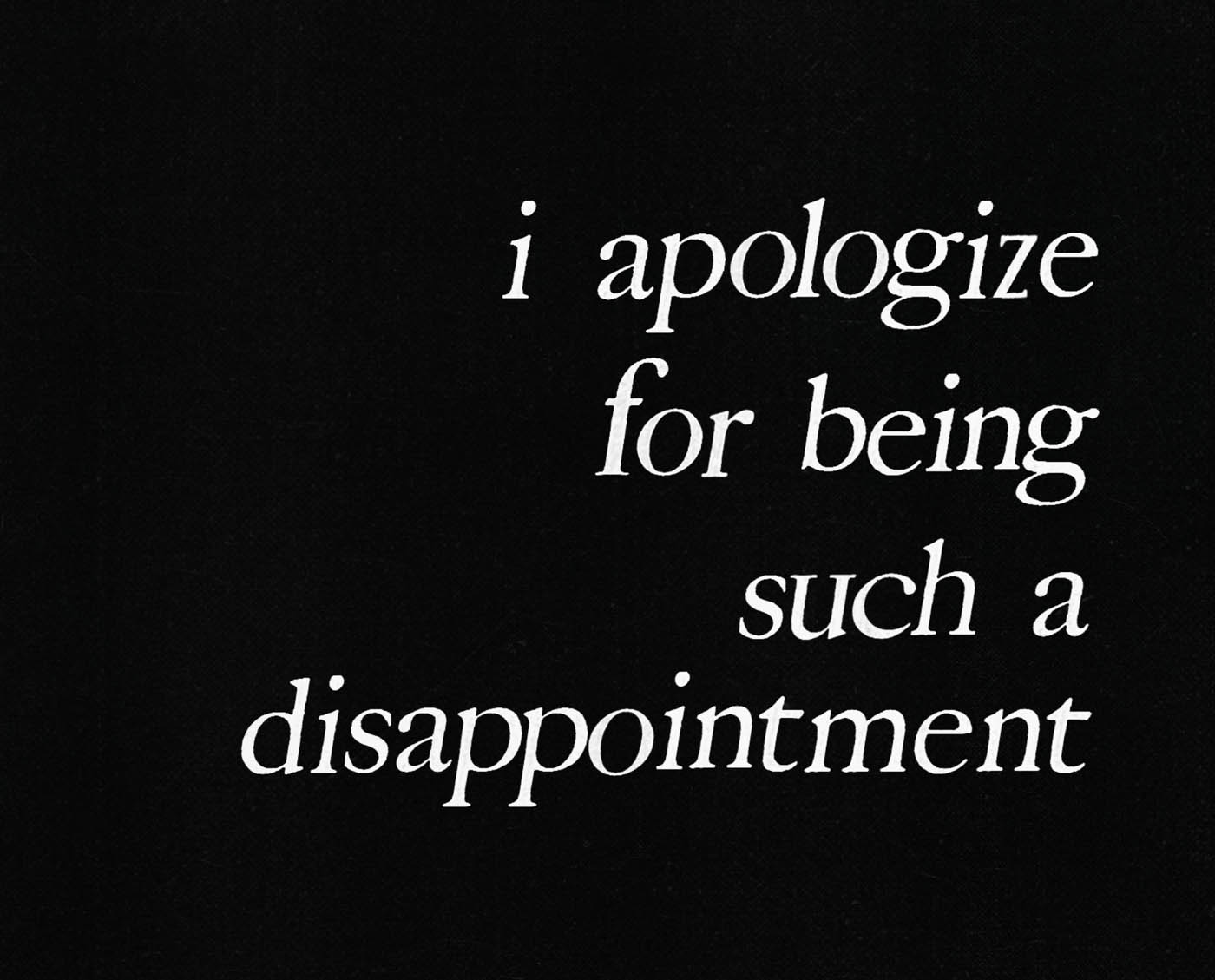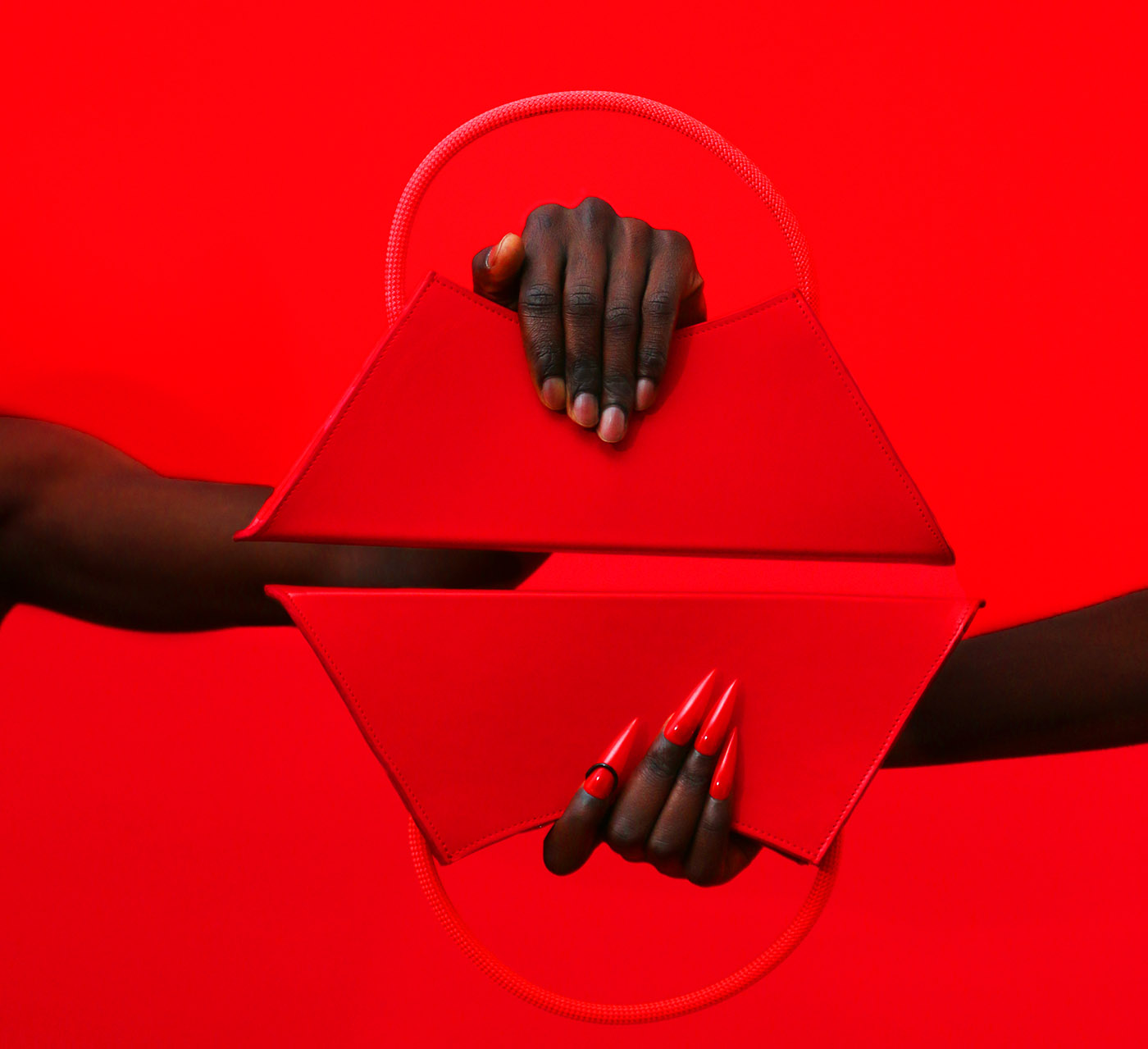The Mercer
The Mercer hotel is not just a place to stay, it is an experience that flings you in the heart of SoHo’s vibrant culture. As soon as you step inside its lobby, you’re greeted by a welcoming atmosphere that exudes style and sophistication.
Its aesthetic is a perfect blend of old and new styles that features exposed brick walls, cast-iron columns and soaring ceilings, all paired with sleek, contemporary furnishings and artworks. The hotel boasts seventyfour luxurious rooms, each one uniquely designed by Christian Liaigre to create a refined as well as comfortable atmosphere.
The lobby is a masterpiece of modern design, spotlighting a dramatic black and white color scheme which creates a bold yet timeless aesthetic. The space is bathed in natural light, producing a warm and inviting ambiance that leads you to linger and take in the surroundings.
As you make your way to your room, every aspect has been meticulously thought out to achieve a flawless integration of opulence and coziness. Rooms are generous and luminous, provided with large windows that offer a glimpse into the lively cultural scene of the neighborhood.
But it’s not just the physical space that makes SoHo’s first hotel so special. This place has a certain energy that’s hard to describe – a feeling that you’re part of something bigger than yourself. Perhaps it’s the sense of history that permeates the building, or the knowledge that so many legendary figures have passed through its doors… It’s no wonder that The Mercer has become a favorite spot among celebrities and discerning travelers alike. It’s been rumored infact, that Marc Jacobs, Leonardo DiCaprio and Johnny Depp are among the A-listers who have stayed at the hotel.
Of course, The Mercer it’s also a hub for creativity and innovation. The lodge has played host to countless events, from fashion shows to film premieres, and it’s a favorite among artists, writers and musicians. The creative energy is palpable.
A destination where history and modernity intersect, where luxury and comfort are seamlessly blended, and where artistry and inspiration are celebrated. Whether you’re visiting New York for the first time or you’re a seasoned traveler, you’ll be surprised how time can stand still in there.
The Mercer, that’s it.




Text: Daniele Tancredi
Photo Courtesy of The Mercer, visit website for more information
Special thanks to Michel Heredia

Patou x Mytheresa: Very the Parisian Feel
Patou x Mytheresa: Very the Parisian Feel
The exclusive capsule collection elaborates the definition of “Parisian Chic” with intricate yet durable designs


“Elegance, beauty, fine arts and fantasy, in these four words you’ll find my collections.” said Jean Patou, founder of the century-old couture house Patou.
Formerly known as Maison Jean Patou, the eponymous fashion house was founded after the idea of liberating women from their restrictive and uncomfortable attire. Known as “the most elegant man in Europe”, designer Jean Patou lowered the necklines, removed the corsets, loosened the silhouettes and shortened the skirts, designing evening dresses with simplicity and chicness. The ambition of this visionary further launched a sports line designed to be worn in daily life. His idea was groundbreaking, and the reception is phenomenal.
Back at that time, the clientele of the fashion house spans from celebrities in Hollywood to the elite in Paris. However, it all ended after the sudden passing of Jean Patou in 1936. The brand lost its aura and went off from the fashion world’s radar. Though deceased at a relatively young age, the legacy Jean Patou has left were precious and meaningful. His accomplishment in womenswear design is highly recognizable, and the fashion house has long been regarded as a pioneer in the transformation of womenswear.
Knowing the backstory of the brand and admiring the achievement of Jean Patou, LVMH acquired the dormant fashion house in 2018 and rebranded it as Patou. The newly revived Patou appointed Guillaume Henry as the artistic director, bringing a breath of joyfulness and refinement to its elegant and fashionable brand DNA. Today, Patou embodies Parisian chic with a touch of glamour, a twist of modernity and a sense of humor.
After Guillaume Henry took the rein, Patou joins forces with brands and talents from different disciplines on special collaborations, and the latest being the collaboration between Patou and Mytheresa. Launched on May 5th 2023, the exclusive capsule collection is an intricate yet durable design that is made to be lived in. Simple, fresh yet elegant, it epitomizes that chic and confident French urban girl that everyone wants to be. Just like what Guillaume said, “I am thrilled to have had the opportunity to collaborate with Mytheresa on this capsule collection; it captures the essence of Paris, a city that has always been an inspiration at Patou. Whether you’re by the seaside or not, this collection will transport you there and make you feel like you’re on vacation every day of the week. I hope that people will enjoy wearing these pieces as much as we enjoyed creating them!”
The Patou x Mytheresa exclusive capsule collection is sold on mytheresa.com from May 5th, 2023 onwards.


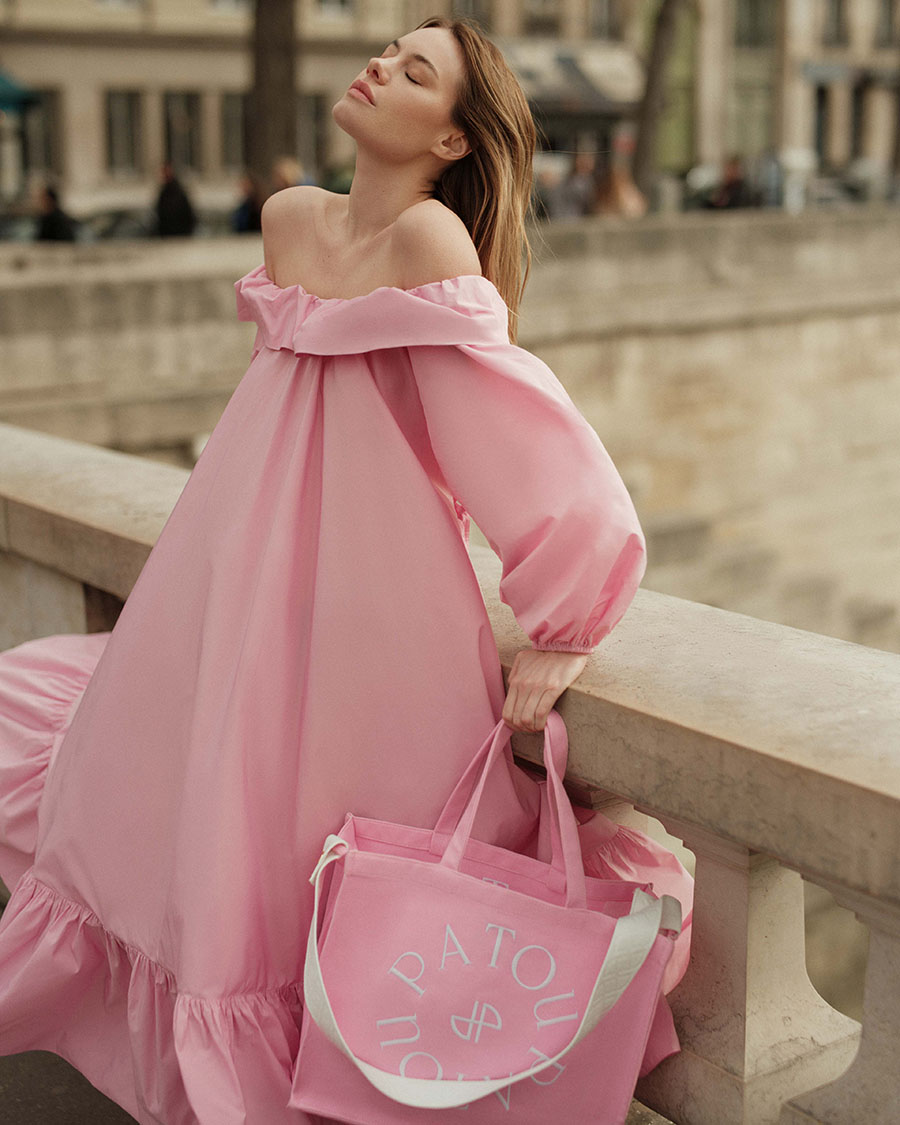
Text: Yves Tsou
Contemporarily Timeless

Contemporarily Timeless
N°21 x Wolford Capsule Collection

Fashion is constantly evolving, and collaboration between brands is an impetus propelling it further as inspirations and perspectives from different creatives confront, collide and converge toward new possibilities. That’s how we perceive the latest collaboration between N°21 and Wolford. Led by the renowned designer Alessandro Dell’Acqua and world top-notch intimate apparel designer Nao Takekoshi, the collaboration encapsulates the imagination of human bodies, the attention to detail and the expert craftsmanship.
Seductive yet elegant, appealing yet regal; the fusion between N°21’s contemporary aesthetic and Wolford’s the timeless design can be seen throughout the whole collection. Jumpsuits, dresses and bodysuits embellished with lace motifs or contrasting asymmetrical cuts in biodegradable material not only refine the silhouette, but also infuse a hint of sexiness to the collection. The capsule also includes distinctive and arousing, yet subtle hosiery, bras and briefs. Extended selection of leggings, skirts and jumpsuits in soft and stretchable vegan leather perfect the collection with diversity.
The collaboration between N°21 and Wolford represents a step forward towards sustainable craftsmanship, with the use of biodegradable materials and attention to craftsmanship. The capsule collection is designed for all occasions. From office to evening events, it exudes a timeless elegance whenever you are at wherever you go.
N°21 is known for their chic and refined designs as well as his attention to femininity. Their ability of combining high quality textiles with modern silhouettes blends perfectly with Wolford’s commitment to innovation. The collaboration between the two brands focuses on the celebration of the beauty and power of women, pushing the boundaries of sustainable design and craftsmanship.
The N°21 x Wolford capsule collection is available at N°21 and Wolford boutiques, online at numeroventuno.com and wolfordshop.com, as well as in an exclusive network of multi-brand stores around the world.




Text: Daniele Tancredi
I Apologize for Being Such a Disappointment

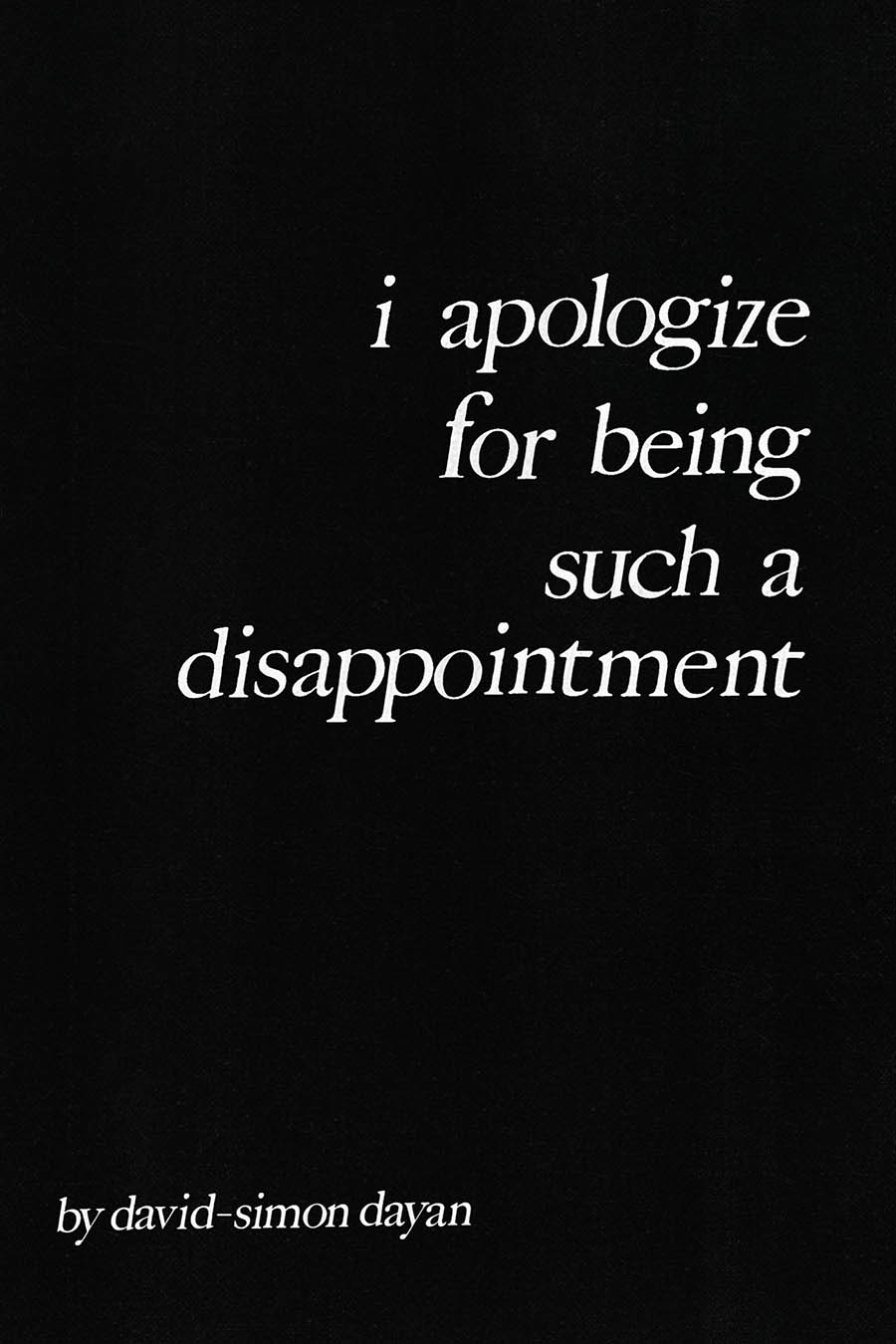
David-Simon Dayan is an artist based in Los Angeles. His work has been published in several publications as well as exhibited in The Museum of Fine Arts Boston, The Little Black Gallery, The Brooklyn Film Festival, and New York City Independent Film Festival.
His visual and written work captures an intimate and poetic look into an avant-garde world with a distinctive visual style and tangible feeling of warmth with his subjects. CAP 74024 has the honor to invite actor Ben Aldridge, a close friend of David-Simon Dayan, for an intimate talk with him on his poetry composition, his inspiration, creativity and sentiment.


What spurred you to write your first poem? Is it something you’d still stand by? Is it in this chap book?
“i’ve written you every day,” which is the first poem in this collection, came about after spending time with someone I really felt connected to. Someone I thought I had, or rather did have feelings for and am now discounting because they were unrequited. And I wanted to tell him, but was too nervous to, and I kept writing these messages and deleting them. And this was the start of my love for writing poetry as an adult. But I recently discovered an old notebook of mine in a dusty box that’s been in storage recently, which mostly consisted of doodles, but then found a few poems. Mostly half-baked, but there’s one I now remember so clearly writing. It contained a line about craving the taste of someone’s cigarette on their lips, and I was probably sixteen when I wrote it, and though it may sound a bit precocious, I stand by it wholeheartedly.
That doesn’t sound precocious at all. That sounds exactly like the musings of a curious sixteen year old and good grounds for a poem. Could you share your process of writing a poem? Do you feel altered by the act of writing poetry?
When I write poetry, it’s always on my phone. I’ll have a consuming feeling that I can’t shake, and it’s a bit like a string. Or a frayed stitch that I have to find the end of and pull. Because it’s exposing a thought burrowed deep in my mind, and it’s getting tangled in there so I have to grab hold and yank it out. And it often feels fleeting, if I don’t pull over and begin to write that thought it’ll burrow further and I’ll lose it. And writing the stream of thought doesn’t necessarily mean I’m free of it, rather I can look at it, I can hold it and read it and hear it speak its existence and try to find some gratitude for it by harnessing its power, one that, moments earlier, was exclusively being used for self-destruction.
These poems are highly personal, at times almost shockingly intimate. Is this work purely autobiographical?
I think I try to bottle intimacy up through my work, though that makes it sound more conscious than it is. The act of reliving intimate moments often dictates what I write—it’s cathartic really. Though I’ve written some that aren’t explicitly autobiographical, each of these are. Autobiography comes most naturally.
You predominantly work as a visual artist; a photographer, do you think and write visually too? For example so much of this work feels like it draws on very real experiences, are you transported to those moments visually whilst writing?
Photography in its execution feels far from writing in certain ways, but when I write, I always have visuals playing in my head. Whether a memory or imagined scenes with another person. When taking a photograph, whether documentary or produced, I always experience a sort of premonition of the composition, even if it’s only a split second before capturing it, and the act is an exercise in achieving the image, bringing it to life. But both are vehicles to a moment. Which might include the feeling of sand under your feet, or the view of a cold, dark room, or the back of someone’s head as you drift asleep. Isn’t all art a vehicle in that way?
Making sense of a moment? Yes it is. You manage to hold both the sensory and the cerebral in these poems, is it hard to strike that balance?
Thank you. And thank you for asking because I didn’t want to go on too much a moment ago, but yes. The sensation feels extremely loud. And it’s usually somewhere in my back, like being stuck in an uncomfortable chair. I struggle to pinpoint these sensations though. My feelings seem to coat my thoughts with no way to separate the two.

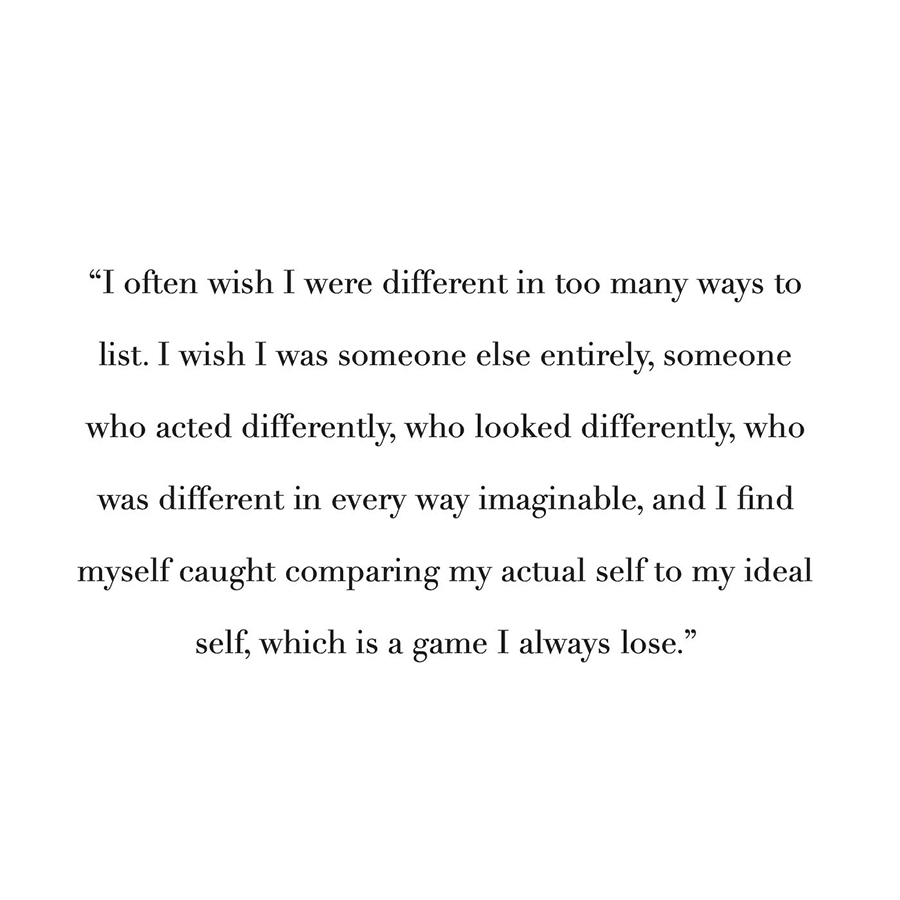
There seems a real push and pull between the reality of how you think and feel and how you ‘should’ think and feel, or how you’d ‘like’ to, almost as though you’re painfully aware of the alternatives and always wrestling with them? Can you speak to that?
Absolutely. I’m constantly judging myself. Holding myself to a different standard than I can achieve. I consider potential often. And failed potential. We’ve all experienced the pressures of performing in a way that satisfies others, family often. Who we are differing from who we should be, who we ought to be. And we internalize these ideas. And we form our own ideas, independently. I often wish I were different in too many ways to list. I wish I was someone else entirely, someone who acted differently, who looked differently, who was different in every way imaginable, and I find myself caught comparing my actual self to my ideal self, which is a game I always lose.
The title of this chapbook, and the last poem in it, is heart crushing. Tell me what disappointment means to you.
Disappointment is everywhere. It’s a possible outcome of every interaction. I have ideas of how I hope things might go, of what I may have the opportunity to experience, and often those hopes are met with disappointment. In this poem, I was referring to a time when I thought I shared an idea of how a relationship would go, but then realized it wasn’t possible. And even though he wanted it, and I thought I did too, I couldn’t fulfill my duties in that role. And I knew he was disappointed in me, that I was a disappointment, and I agreed. Which speaks to your earlier question about the disparity between what I am and what I should be.
These poems seem brutally honest, some may say self punishing. How does it feel to be exposing these parts of yourself?
It’d feel a lot better if someone else would punish me. And it does feel exposing. It definitely did when I first started sharing my poetry, because I felt so open to criticism. So ashamed of these thoughts I was now publicizing in some way. But I’d say now it feels freeing. And the messages I’ve gotten from friends and complete strangers are so meaningful they’ve often moved me to tears. And I’m not lost to the beauty in the power of writing. Poetry is a shortcut to understanding another person, a shortcut to empathy and connection. For thoughts and feelings that feel so shameful, the expression of them has this profound ability to paint them a color I didn’t expect, shaping them into a robust tool.
‘Lost in the Sea’ moved me to tears. In it, you write “the day fades/as does my smile,/allocated to memory, a presence no longer,/of paths crossed,/key to door,/hand to lamp,/open,/click,/a room appears,/one i know well, /staring blankly back at me with no appease/a wave/then quick, a thought, snap out,/as many say, you are your only/so get to know him,/love him,/care for him,/but being alone is remarkably lonely” I felt as though I’d lived it. Tell us about what inspired you to write it.
“lost in the sea” is about letting the worries of reality go, experiencing joy free of the burdens that feel ever-present. How it feels light and freeing, but it’s fleeting, because even though you danced under the heat of the summer sun, and you kissed the skin of a person you met that day, and it might free you momentarily, you’ll still end up in your bedroom, alone, after the day’s dissipated, and you’ll find yourself staring at your wall wishing you could feel the way you felt about them toward yourself.
Ugh, yes. Amen. Despite the evident pain, these poems are also filled with love, almost romance. Would you agree?
I wouldn’t say they’re love poems *laughs*. But to some extent, they are. What can I say? I’m a romantic. But sometimes romance isn’t easy. Expectations aren’t fulfilled. Timing isn’t right, or the characters fall short, but I do hope for romance.
Yes they feel very tethered to love, craving it, losing it, feeling it, cultivating it for yourself, or sometimes the evident lack of self love, that wrestle, love seems to drive them for me, as a reader. You began sharing your poetry on social media. How did it feel to make that first post?
I appreciate you saying that. I felt wildly nervous sharing my poetry for the first time. I felt like a fraud, which isn’t new, but poetry carries so much vulnerability. It’s a one way ticket to the inner workings of my heart and mind. And most of these poems are about feeling lesser than in some way or another. Feeling like an imposter or a loser. But I was pleasantly surprised at the way people reacted. It was unlike any reactions I’ve gotten to photography. I believe because it felt so much more personal, so much more human.

Poems from I Apologize for Being Such a Disappointment
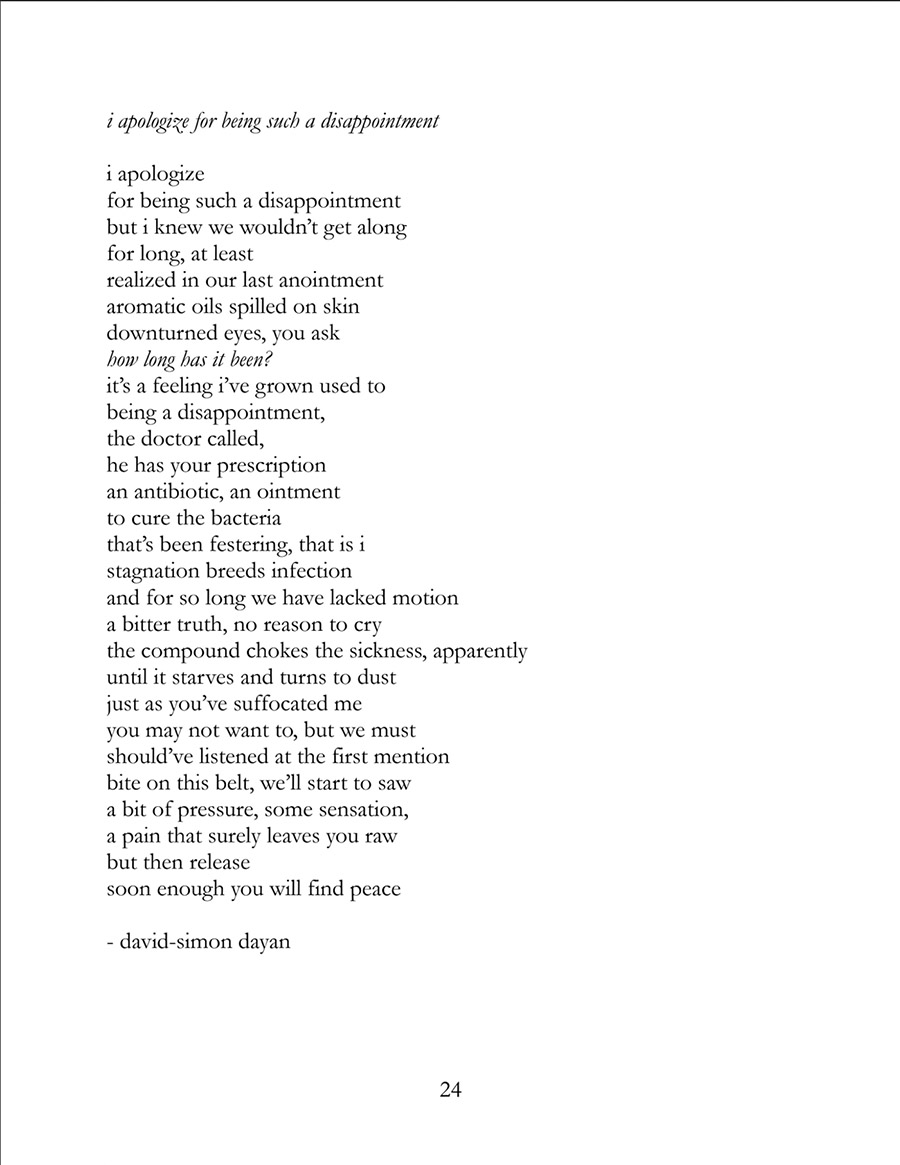



Poetry of David-Simon Dayan
Interview by Ben Aldridge
The Rhythm of Valextra
The Rhythm of Valextra
The kinetic installation in collaboration with Isabel + Helen for Salone del Mobile 2023



As a largest trade fair for furniture design in the world, Salone del Mobile has always been the benchmark event for design and furnishing. After three years of hiatus, downsizing and rescheduling due to global health crisis, Salone del Mobile is finally back to its original schedule. As the scale also returns to normal, Salone del Mobile and the city of Milan is ready to welcome international visitors and design lovers to come back for this mega design fiesta.
Not only do design studios and furniture brands revel in this most acclaimed and anticipated global fair, fashion brands also love to surprise the publics and their clients with exceptional installation arts in collaboration with design firms and artists. As a pioneering Italian luxury leather goods brand born in Milan’s Piazza San Babila, Valextra will not miss the chance to be part of this design carnival. In this edition of Salone del Mobile, Valextra collaborates with London-based design duo Isabel + Helen on an installation The Rhythm of Valextra, rendering kinetic experience of our foundations in engineering beauty.
Throughout many decades of the its existence, Valextra’s identity has intertwined with the spirit of Milan. It is not surprising that the brand’s constant inspiration is the city look: from non-trivial architectural combinations and inimitable elegance, to the celebration of engineering beauty to conceive meaningful everyday objects of desire. With Isabel + Helen’s unique and precise vision, Valextra’s distinctive approach of combining function with beauty unfold in front of the viewers eyes. With the kinetic installation, Isabel + Helen tells the story of Valextra, exploring the mechanism and materials chasing simplification and transformation of complex ideas into readable and understandable meanings. Their love for analog design processes transforms Valextra’s perspective and methods into a dynamic exhibition. Successively on different levels from pattern making and technical tools to brushes for hand-painting the signature Costa black lacquered edging the installation symbioses spontaneity and sobriety.
The Rhythm of Valextra kinetic installation and multi-sensory experience is exhibited in Valextra’s Milan flagship store, on Via Manzoni 3, during Salone del Mobile 2023.
Text: Yves Tsou, Anna Kovaleva
Ascending to New Heights of Style
Ascending the New Height of Style
Embracing the elegance and functionality of skiwear with GIORGIO ARMANI Neve collection

It’s early March, snow on the Alps hasn’t melted yet. As the fashion week marathon and ski season draw to an end, GIORGIO ARMANI invited fashion editors, influencers, key opinion leaders and VIP from EMEA region to join them in Megève, France. The occasion is a three-day intimate experience to celebrate the launch of the Giorgio Armani Neve pop up store.
Opens from December 17th 2022 to March 26th 2023, the pop-up store in Megève is one of the three pop-up stores – other two are in Verbier, Switzerland and Courchevel, France – of the GIORGIO ARMANI Neve skiwear line. The opening of the pop-up stores was preceded by a runway show in St. Moritz last December, unveiling this season’s fashionable yet functional mountain-ready apparels and design accessories.
First introduced in 2021, the second season of the Neve collection does not only accentuate high-performance sportswear and outerwear; the chic and comfortable after-ski clothing is also a not-to-be-missed. With a visit to the pop-up store, guests had a closer look on this season’s proposals.


Aside from the store visiting, GIORGIO ARMANI invited its guests to partake in some mountain activities. Throughout the three days event, they experienced skiing, snowboarding and snowshoe hiking on the breathtaking landscape wearing the latest GIORGIO ARMANI Neve gears and attire. Exquisite delicacies and luxury champagne were served; and friendly dinners with magic shows were to entertain the guests. Everybody enjoyed a convivial and adventurous sojourn full of GIORGIO ARMANI’s remarkable elegance, leaving their most beautiful late-winter memories on the niveous ski slopes.








Event Photography: Valentin Le Cron
Text: Yves Tsou
Handle With Freedom for Ritratte Libere

“Handle With Freedom”: the future that loves the past. Youth, culture and nostalgia meet in a genderless line.
HWF is a young brand born in Italy in 2019 from an idea by Giotto Calendoli, whose passion for cuts and fits comes from the legacy of his grandfather’s clothes from the 50s, that he has never met.
The grandmother gave them to Calendoli and said: “Handle them with care”. The transition from “cure” to “freedom” stems from our generation’s great desire
to be free look to the past but dream of a bold future.
HWF doesn’t just make clothes: its goal is to change the way we see clothes.
Combining old school tailoring with offbeat individuality, HWF is a total look for those who like to wear their own trend.
The brand philosophy “we believe in second chances” is fully expressed with the project “Ritratte Libere”, where on the occasion of Women’s Day on March 8, a limited edition shirt made by inmates of the women’s prison of Pozzuoli (NA) was launched with the claim “Real men are feminists”.
A sunny day, one more day, to remember how strong and free women are! “Everyday is you day” is Calendoli’s idea.
HWF has already cooperated with Palingen and the women’s prison in the past of Pozzuoli in the creation of bags and bandanas, as a symbol of redemption, resocialization and rapprochement with working reality.
“United by love, separated by fear, saved by women!”, this is the concept that HWF wants to spread.
No gender difference, on the contrary, trust in human beings regardless of theirs identity: freedom, this is the watchword!
For more information, go on the handlewithfreedom.com and Instagram of Handle With Freedom.




Videography & Photography: Alessandra Coppola (@alessandrafrancescacoppola), Gesualdo Lanza (@gesualdo.lanza)
Music: Ernesto Massimino Voza (@voza_music)
Graphic: Pietro Pinto
Special thanks to Ministero della Giustizia & Casa Circondariale Femminile Pozzuoli
A Portable Red Lipstick
Born in Paris, the fashionable bag brand ASZPAK is known for its chic silhouette, bald color and clean design. Coming back with the Valentine’s special “Red Lipstick Bag”, the Dalí inspired baguette is ready to be the new “It-Bag” in your closet. Wanting to know more about the story behind the brand and its design, CAP 74024 invites the founder and designer of the brand, Alexandre, to have an intimate conversation with us.
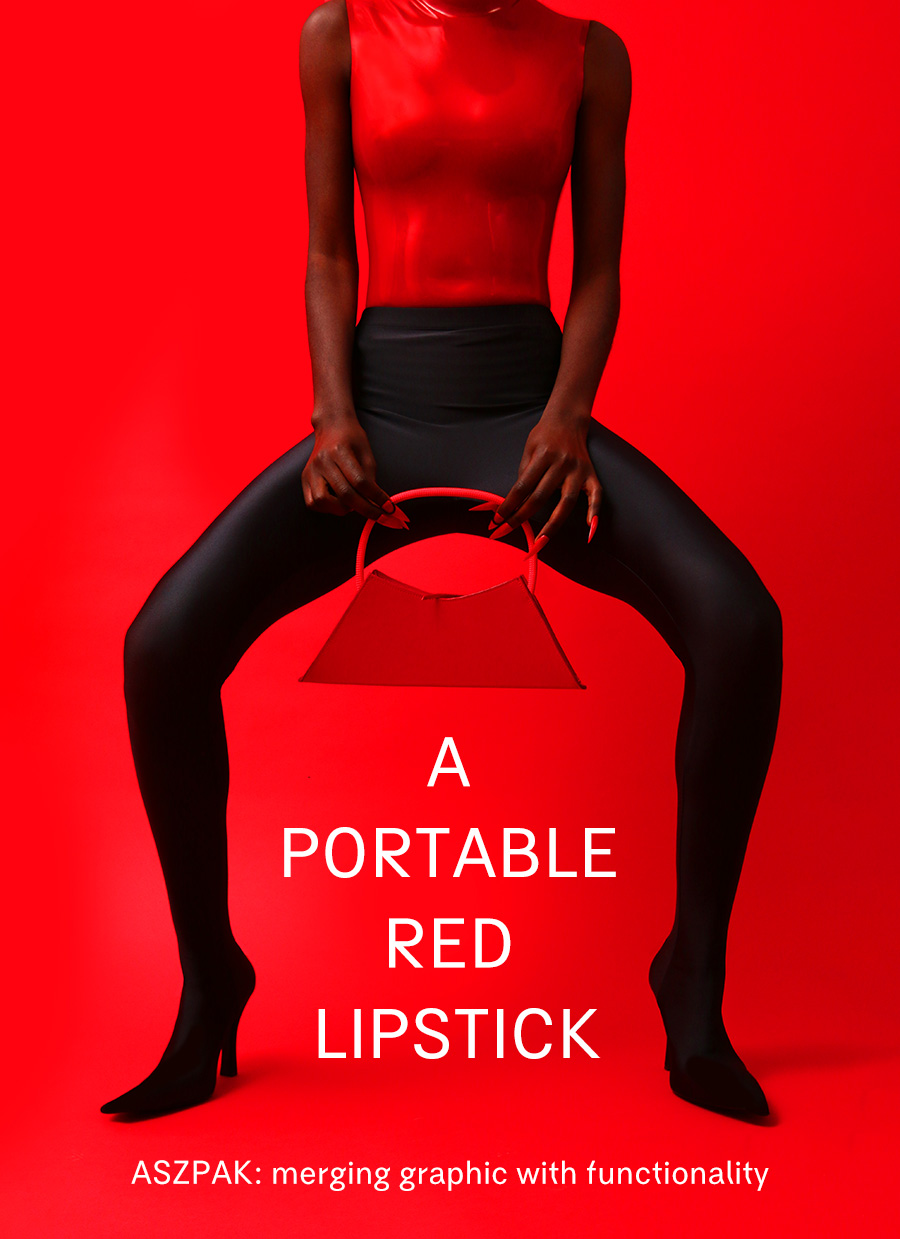
Could you tell us more about ASZPAK? What’s the story behind the foundation of the brand?
ASZPAK is a contemporary leather goods brand based in Paris. The origin of the brand is inspired by my mother’s surname: SZPAK and the first letter of my first name, Alexandre.
We are inspired by the digital culture of the 2000’s with a twist. Currently, we offer two geometric bags shapes where the handles can be switched and extended. I wanted to allow my customers to choose their design while keeping a strong concept and the integrity of my leather goods.
Why do you want to focus on bag design?
I have a background as garment designer and I have been making made-to-measure for clients. Unfortunately, the arrival of the sanitary crisis stopped everything. I realized that I had always been fascinated by materials, whether technical or “lively” like leather. And I thought it was daring to continue to combine them in a different way, to create an “interplay of materials and textures. Something new and different happened with leather because it is a material associated with a real tradition and craftsmanship that immediately fascinated me. Twisting these codes to make a more pop and playful object allowed me to give leather goods a different look. I would like to continue to revisit a collection of classic leather objects and update them for people of my generation.
Matching the rope handle to the leather became my concept and my signature at the same time. Moreover, it was important for me to not create another brand in the landscape. In other words, I wanted a more reasoned and simple creation with a minimal impact on the environment. I try to fight at my level against waste and to promote short chains. The leathers I use are unsold from big companies that are destined to be destroyed and they have a traceability that I communicate to my customers.
What are your visions of ASZPAK?
I now perceive ASZPAK in a more international perspective because our experiences in department stores and our international retailers confirm that the brand is in demand. We had the incredible opportunity to sell our products at Printemps Haussmann and this was an important turning point in the development of the brands. I approached the creation of my brand in a very instinctive way and it was by starting to create it by myself that I found my brand identity. I wanted graphics, geometry, simplicity in the way of carrying a bag, but above all to define a creative vision that would stand out with a strong and committed product.
There are so many big fashion houses and niche brands designing fashionable, interesting and wanted bags. What are the traits that make ASZPAK stands out from others?
We distinguish ourselves from other brands because we prefer to work on permanent designs that are graphic and have a specific function. They are fashionable but always practical and functional. The design is permanent but the leathers change regularly because we have a limited sourcing. The goal is not to multiply a multitude of shapes but to focus on an iconic shape, a symbol and to play with the materials. I have noticed that each brand develops a symphony of symbols that allow it to be recognized in a blink of an eye and to differentiate itself. In this sense, ASZPAK’s symbolism consists of a leather base topped by a neon handle. The attention to material quality, the graphics and the pop colors are the starting points in the development of our collections.
Now let’s focus on your latest design, the Red Lipstick Bags (which also come in white…). Can you guide us through the design of it in details?
I wanted a red monochrome bag for Valentine’s Day! A warm bag that will highlight a winter silhouette. For this capsule I wanted to talk about love and sensuality through the color red but also to play with the curves of the bag that imitate red lips. Our bag is also available in white and soon in a large size.

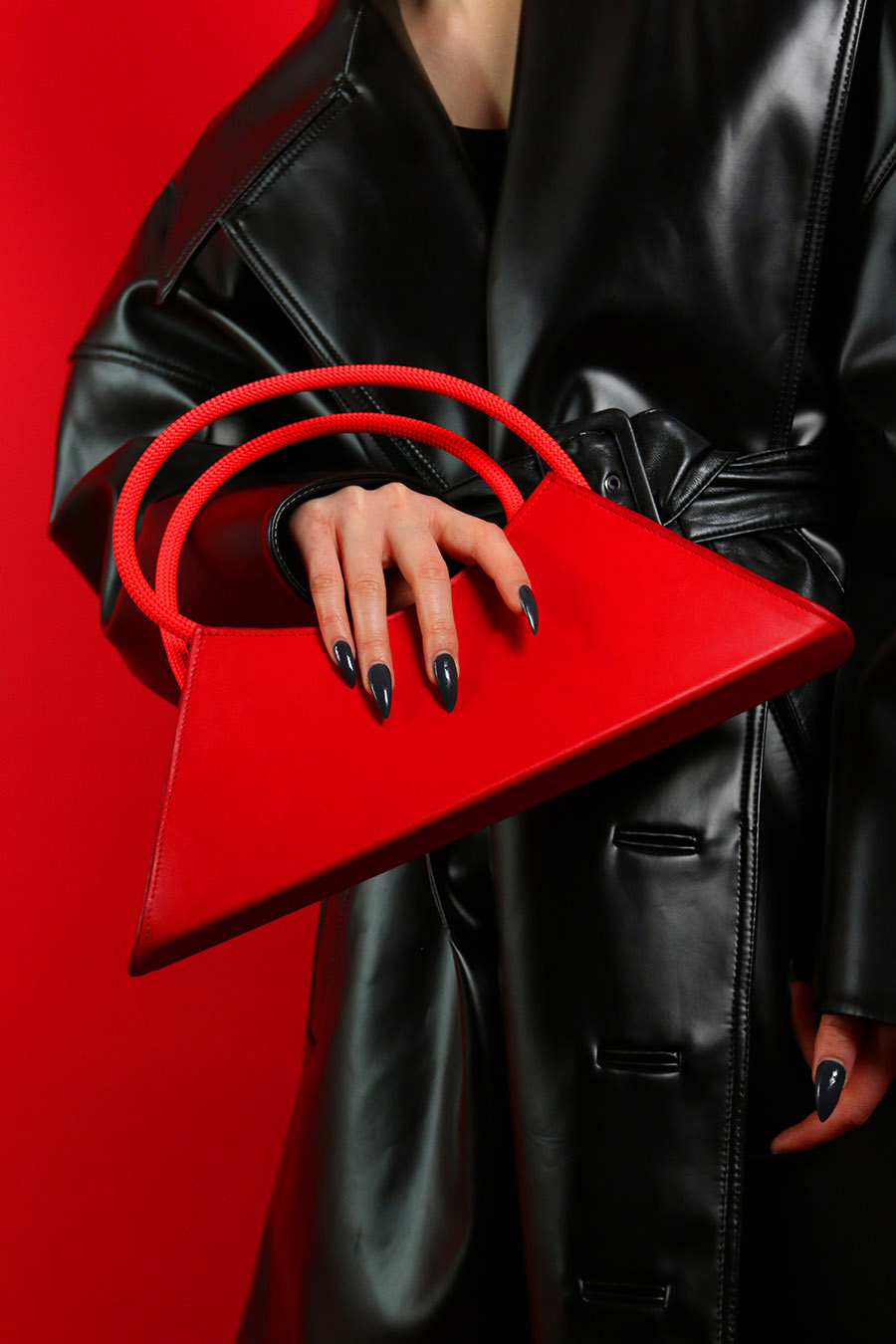
We learnt that the inspiration of the Red Lipstick Bag actually came from Salvador Dalí’s surrealistic Mae West Lips Sofa, but what draws you to take this reference as an inspiration?
I started to get interested on this reference last summer. I was in Mexico City this summer and I had been impressed by the brightness of the colors of the city and the food. I think it was this that inspired me at first to focus on very intense and less folded colors. Then I went to an exhibition about surrealism in a museum downtown and I came across this sofa designed by Dalí. Reading about its design and history, I discovered that this sofa is a tribute to the mouth of Mae West. It is both a tribute to this powerful woman, and for me, an essential part of the design history. I was interested in playing with this symbol for an editorial and referring to it.
Do you often take inspiration from art and furniture design? What are other sources of inspiration you have?
Design and art – especially painting – are my primary sources of inspiration. Traveling allows me to be surprised, especially in terms of feelings. I think that yes, unconsciously or not, I am often inspired by the design of objects, it is often a starting point for a form or a boldness. I looked a lot at designers like Memphis design or Oki Sato.
Aside from the Mae West Lips Sofa, what are the other inspiration and references you have in your accessories design?
Shiro Kuramata’s designs such as the Progetti Compiuti chest of drawers and Charlotte Perriand’s boomerang desk are sources of inspiration, I like the way they question everyday objects and transform them into manifest and graphic pieces.
You mentioned about using deadstock leathers and recycled fabrics. In today’s world, many designers are doing so and sustainability is repetitive concept in many design. From your perspective, why is making eco-conscious design this important?
Eco-conscious design is important for me because it is now a real stance and awareness. Even if everyone tends to think that recovering excess materials and reusing them has become normal, we must remember that the storage areas where we pick up our materials, destined for mass destruction, is a consequence of an intensive production system. I do it and it is still not enough… that’s why we should democratize it all together! Our generation has the duty to do what is necessary and to use what exists, therefore it is important to shout it loud and strong!
The eco-consciousness does not stop at the supply side. It’s a matter of working with responsible materials but also of awakening a consciousness in design and production methods. Promoting short circuits is also something to think about, I make my bags in France, I get my supplies in France etc… We also have to be aware of how our bags are made, in what context and in what quantity. The goal is to create a movement and it is good news that things are moving in that direction.
We also limit our bag references and prefer to focus on one or two designs that work and incarnate the identity of the brand. I must admit that it is an easier exercise for leather goods because the bag goes through the trends more easily but this observation must also be infused in the ready-to-wear that until today continues to multiply the references, sizes and quantities despite the wishes of a more responsible sourcing.
What are the future plans for you ASZPAK?
We want to continue this dynamic and I believe that 2023 will be a great creative year with great business opportunities. We will be at Première Classe for the first time in March and we will exhibit our new designs. I would like to continue to rethink leather goods in a contemporary way and imagine new accessories. I simply dream of being able to continue to have the freedom that my profession allows me. To continue to transmit my energy and my ideas through my designs.
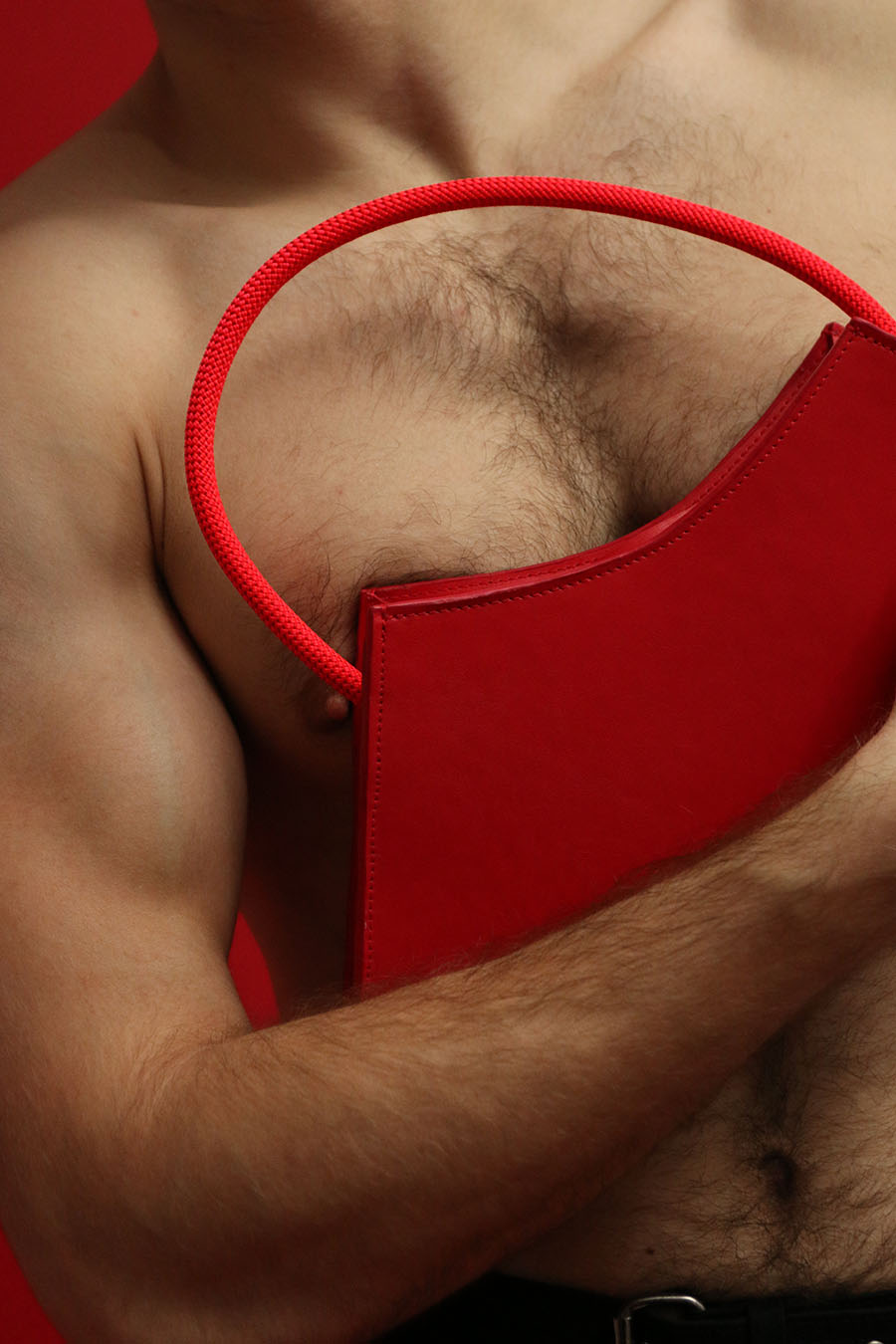
Photographer : Florian Cros (@floriangc_)
Stylist & Art Director: Léo Rouault (@leorouault)
Make-up : ThomyK (@thomykmakeup)
Nails : Magda S. (@nailsbymagda.s)
Models : Chris (@chrisilentus), Stas (@sslaventiy), Giuli (@giuli.pingitor), Kaba (@real_kaba), Binta, Bobby (@30337.6)
Interview by Yves Tsou
Martial: Here to Break the Gender Binary
After unveiling its first collection of high-end, degendered swimwear in July 2022, Paris-based label Martial reveals a pre-collection that sets the tone for summer 2023. What is degendered swimwear and why is it important to have it in today’s society? To better understand these questions, CAP 74024 invite the designer and the head of Martial, Martial Charasse for a decent talk about his concept, his design, his journey and the stories behind them.
Could you tell us a bit about Martial? What’s the motivation behind founding this brand? Is any interesting stories or anecdotes you want to share in this journey?
First of all, before being the name of the brand, Martial is my first name. That of a child born on an Auvergne farm that is passed down from generations to generation. I have always felt out of step with the agricultural world in which I grew up. Preferring to imagine doll clothes rather than accompanying my parents in the fields. This is why after I graduated from high school, I decided to move to Paris to study fashion so as to realize my dream, to create my own brand.
It was after my participation in the Hyères Festival, and the numerous people I met there, that everything began.
An anecdote? I accepted a job as a swimwear designer in 2020, on the other side of the globe (Madagascar) without knowing anything about swimsuits. At that time, I found it exciting to go on an adventure, I had no idea that I would have real crush for this kind of product. Unfortunately, the pandemic miscarried this project, but my desire to create my swimwear brand was born.
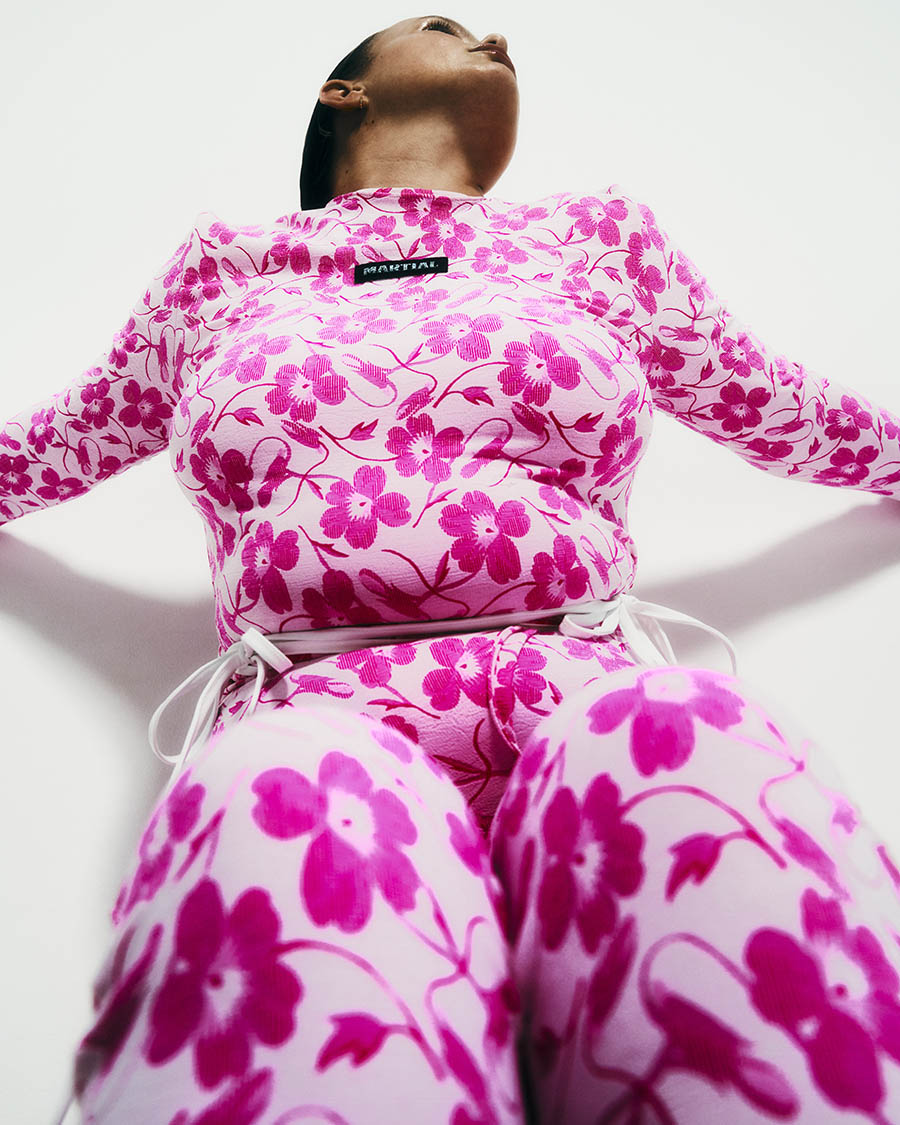

This is the second season of your innovation swimwear brand; it is nascent but full of potential as we can see. Could you guide us through the concept and the mood of your second season’s design?
Actually, I regard this second drop as a teaser, the teaser for my next spring summer collection. I reveal new colors (sky blue, khaki…), a more urban vibe because my pieces are designed to be worn also in town or for partying; and together with jeans, under a transparent dress…and so on. It is also an opportunity to present my first unisex ready-to-wear set composed of a top and pants.
As an extension of the first season, what was the connection that you link the two seasons’ design?
Exactly, it is an extension of my first collection, I take emblematic models from the first collection in new colors. As for my first ready-to-wear set, it uses a floral jacquard fabric from my first collection. I also wanted to keep the same guideline of my first collection; the contrasting lacing and the color mixes.

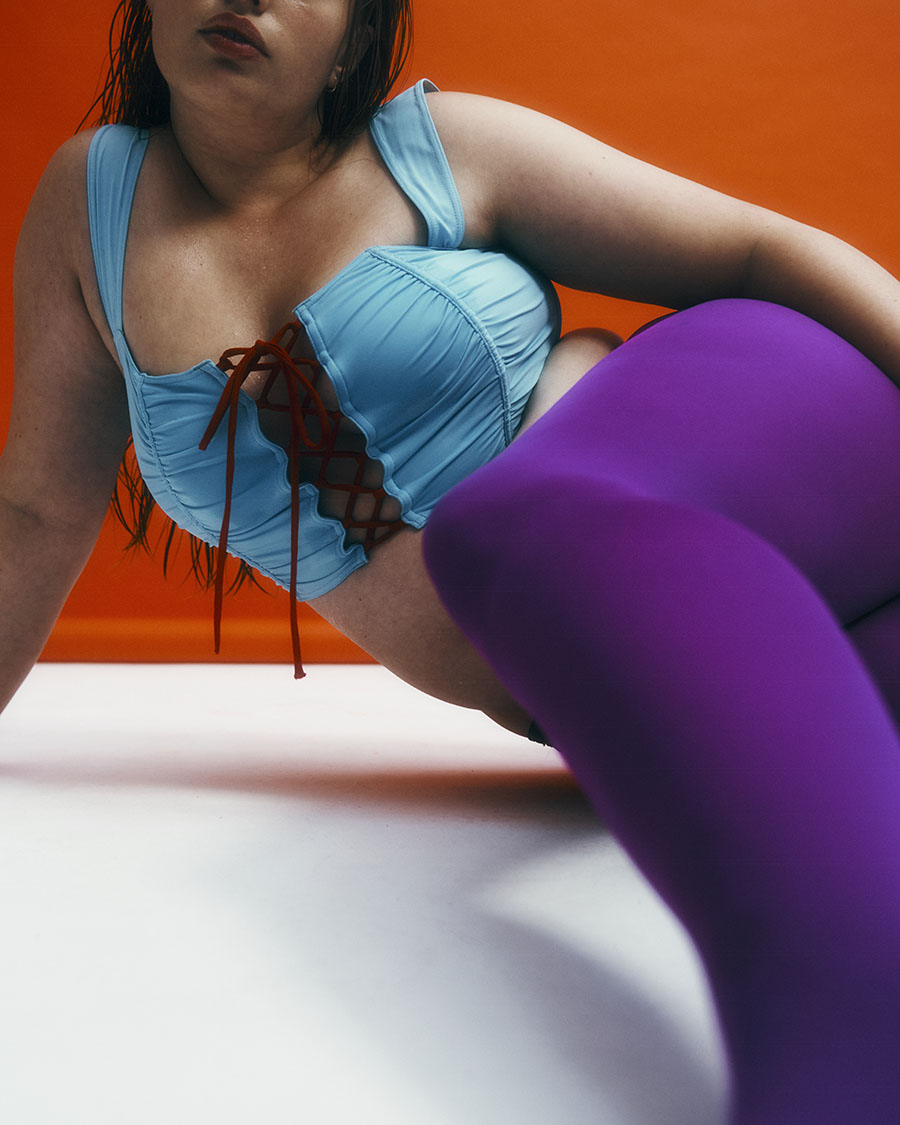
Genderless swimwear is still quite a new concept today, but with the awareness of non-binary gender self-identity rising, it is nice to see someone initiate the moves and produce genderless swimwear in the market. What makes you decide to initiate this move?
It was my personal story that naturally pushed me to embark on this adventure. Since childhood I have always had a pronounced taste for androgynous figures. My wardrobe is also composed of many “feminine” clothes. Unfortunately, they are not always well-fitted for a male body. From this observation and experience, I initiated the idea to find solutions of abolishing the gender boundaries.
Continuing from the previous question, who are the existing clients of your genderless swimwear, and who will the potential clients be?
I believe and imagine my customers to be those who are the real spearheads to break the gender boundaries. They are looking for pieces that allow them to feel comfortable, whether the anatomy agree with their gender or not.

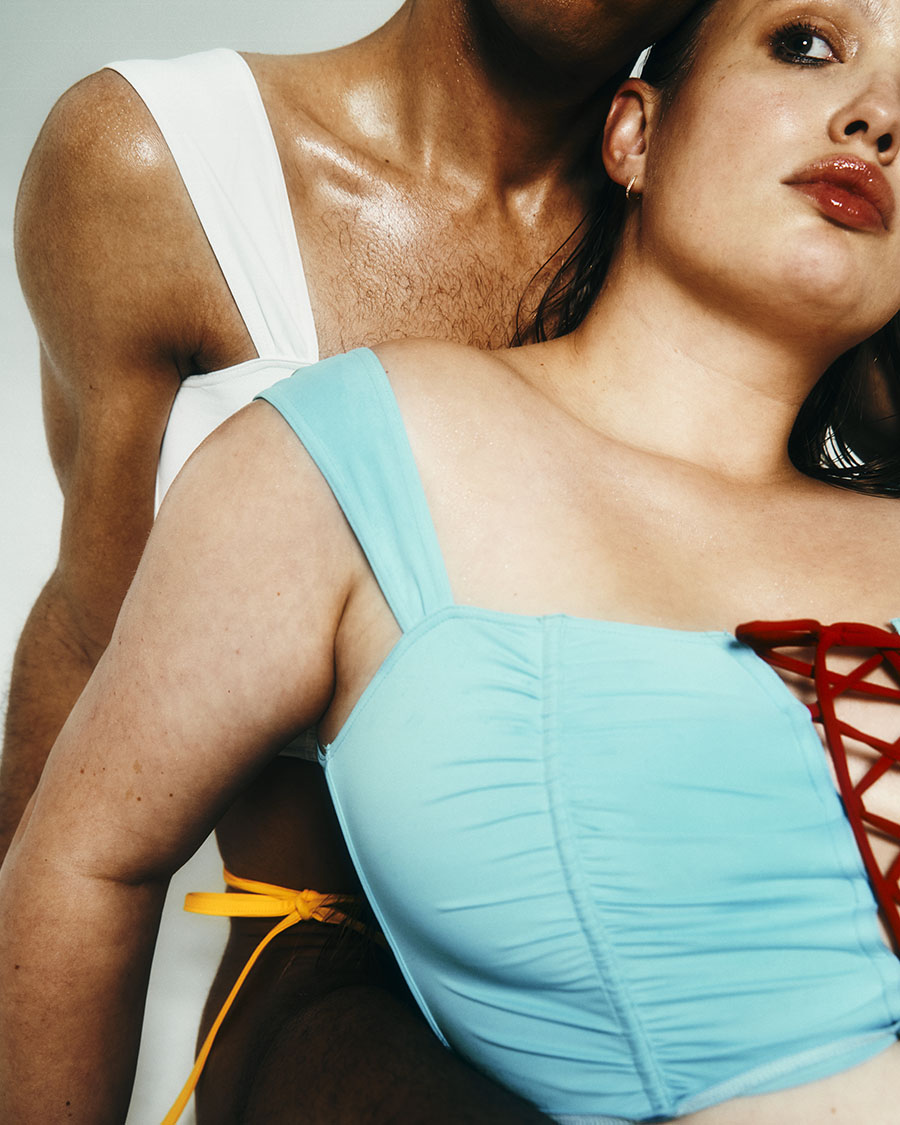
Normally when we talk about unisex design, we are talking about ready-to-wear outfits. It is not common to have genderless design in intimate wears. How do you cross the biological characteristics and eliminate the boundaries while respecting the anatomy?
Indeed, that was the main challenge, we cannot deny the anatomical differences even if we want to. Also, most of unisex clothes on the market are using oversize shape to overcome the biological difference, and it is impossible for a swimsuit to follow suit. This is the reason why each model of our swimwear has two patterns taking into account the anatomical characteristics of each gender. We want to offer upshots that are visually identical, regardless of the morphological characteristics of the model. It was therefore necessary to find solutions at the pattern stage, to finally create the illusion of a single model.
As an emerging brand, how do you position your brand in this market?
My brand is meant to question a new relationship around our body, our sexuality but also our identity. The borders initially established by the society have never been so fragile, and that’s a good thing! This is with a genderless swimwear world that I wanted to definitely break the codes.
Could you share with us some insight in your next season’s project if it is not a business secret?
Of course, it is a business secret haha. But what I can tell you is that I am currently working on various accessories and bags on top of the swimwear. Moreover, I want to mainly offer more ready-to-wear. On top of that I want to confection some extravagant image pieces with unexpected materials…SO GUYS, STAY TUNED!
Photography: Enzo Tonati (@je_sors_ce_soir_)
Creative Direction: Julie Etienne des Rosaies (@julieetiennedes)
Styling: Taoriki Dexter (@toarikidexter)
Casting: Chouaïb Arif (@chouaibarif_casting)
Hair: Vincent Yves-Marie Zimberlin (@vincentzimberlin)
Make up: Azusa Kumakura (@azusabeauty_)
Photo Assistant: Soraya Sanini (@sosoinpariss), Jacky Varlet (@jackyonacid)
Model : Julia-Kim (@julikimjean), Rose (@rrrabia__), Ritchy Oricci (@ritchycobraldelavega)
Interview by Yves Tsou
ModaPortugal 2022 - A Spectacular Fashion Showdown
Porto, mid-December. Winter in North Portugal is chilly. With the continuous drizzle and the wind blowing along the valley, a damp smell envelops the slippery city. But this did not dampen the enthusiasm and excitement of those young fashion talents who have just arrived. Hailing from six European countries, eighteen aspiring fashion designers were welcomed by ModaPortugal for the annual event. Over the course of their four-days sojourn, the designers visited six of the top manufacturers from Portuguese’s thriving textile industry, had an in-depth experience with Portuguese cuisine and wine; and most importantly, participated in a fashion showdown for the best collection of the year.
These young designers, representing eight fashion institutes all over Europe, came to Porto with their fresh and unique vision. A jury of seven fashion experts from different disciplines convened in a beautifully decorated chamber in Pálacio da Bolsa (Stock Exchange Palace), the city’s Neoclassical architectural gem and the UNESCO World Heritage Site, to evaluate the young designers’ collection from concept to outcome. After an intensive day of evaluate, they selected a best collection from each of the six countries, and a best collection across all.


Creative director Miguel Flor’s installation “LIFE CYCLES” took place in Salão Árabe, Pálacio da Bolsa
Designer Taneli Ukara from Aalto University is the winner of Best Collection Award Finland. Ukura approached the collection as a puzzle and developed an alternative pattern-making methodology under the principle of zero-waste pattern cutting. This new method allows the clothing to structure into a more universal, pre-defined and multifunctional elements which could be purposed in garment in various different manners.
The title of Best Collection Award France was given to Zoé Gerolymous from Institut Français de la Mode. In her collection “RANDONNÉE”, Gerolymous wanted to return to the original purpose of clothes, which is to cover oneself, and focused on the practicality and utility of the garment.
Experimental laboratory Agapornis snatched the Best Collection Award Switzerland. Founded by designers Zoé Marmier and Louise Jarrige, the duo collaborated on their collection “SELF LOVE LETTER” during their masters at HEAD Genève. Their cute and romantic design blended couture perfectly with sexy and functional ready-to-wear.
Chinese designer Fengqin Yue from Polimoda was crowned as the winner of Italy. His collection “WARRIOR, POET” juxtaposes two groups of people who hold contradictory view on warfare. Poets laud for peace and warriors appear in wars, this contrast made him think about the pain that wars bring to mankind. Using fabrics and support materials that came only from vintage military garment, Yue’s collection also incorporated some unconventional materials like parachutes, tents or camouflage nets. Through this collection, Yue wanted to express his views on calling for peace and opposing wars.
Also from East Asia, award-winning South Korean designer Dayoung Jang from London College of Fashion joined the league as the winner of Best Collection Award United Kingdom. Her collection “HYPER BOBUSANG” focuses on the functionality and versatility of outfits, but with a humorous touch. Taken inspiration from her personal travel experience, she wanted to offer some experimental suggestions on how to dress wisely while traveling. The long-haul flights from Seoul to London often got her sweaty, and to carry a lot of luggage with her is truly bothersome. These inconveniences inspired her to merge accessories like neck pillows, belts, pouches or backpacks to her garments. The draping resembles the sweat-drenched clothing, and the waterproof fabrics enhance the functionality of the garments.
The winner of the host country Portugal is Andreia Reimão from Modetex. Previously the winner of Portugal Fashion’s Bloom and a finalist at ModaLisboa’s young designers’ competition, Reimão is not new to fashion competitions. Her collection “PLEASE (BEHAVE YOURSELF)” is dedicated to the fragility of masculinity. The concept came from Polish photographer Paweł Jaszczuk’s photography series of drunk Japanese men in suits and ties. These men in formal attire succumbed to alcohol and slept alongside the streets in uncontrolled postures, but they were inserted well in the society. Reimão aimed at creating a feeling of being out of place, designing a collection that seems incoherent while it is actually not.

Designer Ivan Hunga Garcia explains his collection to the jury in the beautifully decorated chamber

Norman Mabire-Larguier is the winner of ModaPortugal Best Collection Award
The evening culminated in Swiss designer Norman Mabire-Larguier taking home the biggest prize. Sensitive and radical, his ModaPortugal Best Collection Award winning collection is an intimate and progressive personal journey in quest of freedom. Mabire-Larguier refused to label his collection or to summarize its interpretation in a few sentences. According to him, the strongest way to connect with his work is through breathing. Between inhaling and exhaling, he dived into the heart of his emotions, gave shape of his inner world and expressed the unspeakable feeling of hinderance that has suffocated him in his development as a queer person through his garment. Body is his raw material and garment is medium. He worked directly in 3D, on the body of someone whom he felt close to. This rendered a sense of intimacy to his design, which won him the favor of the jury and the ultimate glory.
Aside from the seven award winners, there are also some designers worth mentioning. Australian-Taiwanese designer Samuel Lewis, who represented Polimoda and Italy, pulled out a quirky and whimsical collection filled with art and cultural reference. Inspired by Lou Reed’s anthology “Do Angel Needs Haircut?”, the idea of the collection is to prove that an angel is not necessary all that it seems. Due to his parents’ job, Lewis has lived in various countries around the globe. Behind his loud, campy, eccentric and flamboyant design, the collection is actually a tender retrospect of his childhood love and memories, his cross-cultural identity and the artworks he has seen.
Also represented Polimoda and Italy is Polimoda’s 2022 Best Collection Award winner Federico Di Nisio. His collection “MODERN ANTINEUTRAL” is a manifesto of cubism in the early 20th Century. The main concept of his collection is liberty, and it reflects on the materials and the techniques he used. Growing up, Di Nisio searched freedom through skateboarding and sailing. He combined scraps from sail and styling details of skater boy with the silhouette of the 40s tailoring. As Di Nisio stated, he loves to match tailoring with sportswear, making wearable and fashionable clothes for people.

The final credit of the fashion showdown

The ModaPortugal event was held in the beautiful Neoclassical building Pálacio da Bolsa.
Portuguese designer Ivan Hunga Garcia’s collection is based on the theory of object permanence. He used SCOBY leftovers from fermenting Kombucha as material to make fabrics. The symbiosis of bacteria and yeast is alive and is susceptible to external factors. This kind of uncertainty will affect the eventual outcome. According to Garcia, the collection is a combination of all of his long-term projects, which is to create biodegradable designs. Since his materials are alive and organic, the clothes will eventually die and be completely waste-free and sustainable.
Also taking about sustainability is designer Benjamin Ethan from London College of Fashion. He used recycled garments and fabrics to create his collection “Cloud Troubadours”. As a sustainability practitioner and a person who always has his head up in the air, he reinterpreted the everchanging form of cloud within the textile and gradually shifted the narration to the innovative ways of reusing and repurposing fabric scraps, deadstock and vintage garments.
Closing the ModaPortugal fashion show is the design of Leo Prothmann from London College of Fashion. It is no exaggeration to describe his collection as the most theatrical and fetishistic of the night. Inspired by German artist Rebecca Horn’s philosophical concept, the collection is a personal journey of finding “safe spaces” amongst outsider communities. This led him to look at loads of sculptures because they are silent and they looked at him back without judgement. His fondness for Japanese bondage art Shibari inspired him to incorporate ropes into his design, and his childhood memory of lorry carrying water to his home in Mallorca gave him the idea to fix metal on the shoe soles. All the elements resonate with Berlin’s underground techno subculture, which is known for its diversity and open-minded energy.

Finland | Ellen Rajala, Jarno Kettunen, Taneli Ukura (from left to right)

France | Mouyakabi Diomandé, Paul Billot, Zoé Gerolymos (from left to right)

Italy | Federico Di Nisio, Fengqin Yue, Samuel Lewis (from left to right)

Portugal | Andreia Reimão, Ivan Hunga Garcia, Rita Miguel Costa (from left to right)

Switzerland | Agapornis, Neils Raonison, Norman Mabire-Larguier (from left to right)

United Kingdom | Benjamin Ethan, Dayoung Jang, Leo Prothmann (from left to right)
Text: Yves Tsou



